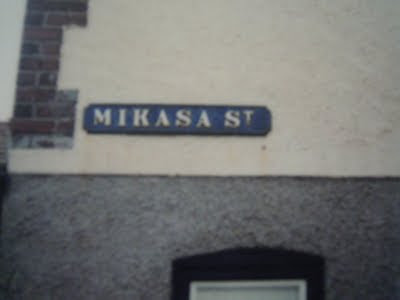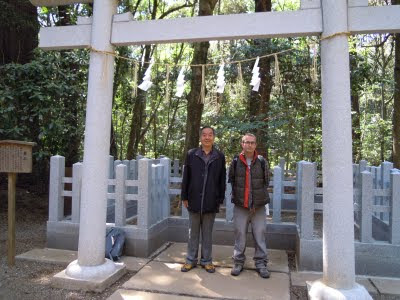Verny Park
When you get off at JR-Yokosuka Station, you will see a park named 'Verny Park.' The park was named after a French engineer F.L.Verny. It stretches from the east to the west. In the middle of the park there are two busts. One is of Verny's and the other is of a Japanese whose name was Oguri.
 Verny came to Japan at the request of the Edo(=current Tokyo) Government to build an arsenal and steel mill in Yokosuka. They existed at the current park.
Verny came to Japan at the request of the Edo(=current Tokyo) Government to build an arsenal and steel mill in Yokosuka. They existed at the current park. 
 In a memorial hall at the park Verny's achievements are being exhibited. The picture above is the whole scene of Yokosuka Steel Mill.
In a memorial hall at the park Verny's achievements are being exhibited. The picture above is the whole scene of Yokosuka Steel Mill.  His great grandson visited Yokosuka with his wife.
His great grandson visited Yokosuka with his wife.  To the right of Verny's bust there stands a bust of Oguri who was a local officer and contributed to the construction of the arsenal.
To the right of Verny's bust there stands a bust of Oguri who was a local officer and contributed to the construction of the arsenal. Verny was also assigned to build a western-style-lighthouse in Japan. The picture above is Kannonzaki Lighthouse. Verny's assignment to build lighthouses was succeeded to Richard Henry Brunton whom I introduced in my yahoo blog.
Verny was also assigned to build a western-style-lighthouse in Japan. The picture above is Kannonzaki Lighthouse. Verny's assignment to build lighthouses was succeeded to Richard Henry Brunton whom I introduced in my yahoo blog.
US Navy Base To the west of the park there is a vast naval base of the United States of America. It is not easy to enter the base, so I took pictures from outside. This is a facility named Club Alliance.
This is a facility named Club Alliance.  This is a gate of the US Navy Base in Yokosuka
This is a gate of the US Navy Base in Yokosuka  This is another gate. An anchor has been exhibited there.
This is another gate. An anchor has been exhibited there.
Mikasa Park is to the west of the US Navy Base. Mikasa was a warship which was built in the United Kingdom. There is a statue of Admiral Togo in front of Mikasa. Mikasa was named after Mt. Mikasa in Nara prefecture.
Mikasa was a warship which was built in the United Kingdom. There is a statue of Admiral Togo in front of Mikasa. Mikasa was named after Mt. Mikasa in Nara prefecture.
 The ship was built in a city named Barrow in 1899. The red mark shows where Barrow is.
The ship was built in a city named Barrow in 1899. The red mark shows where Barrow is. In Barrow there is a street named Mikasa St. as the picture above shows. To read detailed informations about Mikasa click here.
In Barrow there is a street named Mikasa St. as the picture above shows. To read detailed informations about Mikasa click here.
Commodore Mattew Calbraith Perry(April 10,1794-March 4, 1858) ; In 1853, United States naval Commodore Perry arrived in Tokyo Bay with his fleet of Black Ships and came ashore at Kurihama, in the southern Yokosuka, leading to the opening of diplomatic and trade relations between Japan and the United States. Perry's bust in front of a memorial hall at Kurihama
Perry's bust in front of a memorial hall at Kurihama
 A big monument of Commodore Perry's landing on Japan
A big monument of Commodore Perry's landing on Japan This is a coast of Kurihama on which Perry landed.
This is a coast of Kurihama on which Perry landed.
When you get off at JR-Yokosuka Station, you will see a park named 'Verny Park.' The park was named after a French engineer F.L.Verny. It stretches from the east to the west. In the middle of the park there are two busts. One is of Verny's and the other is of a Japanese whose name was Oguri.
 Verny came to Japan at the request of the Edo(=current Tokyo) Government to build an arsenal and steel mill in Yokosuka. They existed at the current park.
Verny came to Japan at the request of the Edo(=current Tokyo) Government to build an arsenal and steel mill in Yokosuka. They existed at the current park. 
 In a memorial hall at the park Verny's achievements are being exhibited. The picture above is the whole scene of Yokosuka Steel Mill.
In a memorial hall at the park Verny's achievements are being exhibited. The picture above is the whole scene of Yokosuka Steel Mill.  His great grandson visited Yokosuka with his wife.
His great grandson visited Yokosuka with his wife.  To the right of Verny's bust there stands a bust of Oguri who was a local officer and contributed to the construction of the arsenal.
To the right of Verny's bust there stands a bust of Oguri who was a local officer and contributed to the construction of the arsenal. Verny was also assigned to build a western-style-lighthouse in Japan. The picture above is Kannonzaki Lighthouse. Verny's assignment to build lighthouses was succeeded to Richard Henry Brunton whom I introduced in my yahoo blog.
Verny was also assigned to build a western-style-lighthouse in Japan. The picture above is Kannonzaki Lighthouse. Verny's assignment to build lighthouses was succeeded to Richard Henry Brunton whom I introduced in my yahoo blog. US Navy Base To the west of the park there is a vast naval base of the United States of America. It is not easy to enter the base, so I took pictures from outside.
 This is a facility named Club Alliance.
This is a facility named Club Alliance.  This is a gate of the US Navy Base in Yokosuka
This is a gate of the US Navy Base in Yokosuka  This is another gate. An anchor has been exhibited there.
This is another gate. An anchor has been exhibited there.Mikasa Park is to the west of the US Navy Base.
 Mikasa was a warship which was built in the United Kingdom. There is a statue of Admiral Togo in front of Mikasa. Mikasa was named after Mt. Mikasa in Nara prefecture.
Mikasa was a warship which was built in the United Kingdom. There is a statue of Admiral Togo in front of Mikasa. Mikasa was named after Mt. Mikasa in Nara prefecture. The ship was built in a city named Barrow in 1899. The red mark shows where Barrow is.
The ship was built in a city named Barrow in 1899. The red mark shows where Barrow is. In Barrow there is a street named Mikasa St. as the picture above shows. To read detailed informations about Mikasa click here.
In Barrow there is a street named Mikasa St. as the picture above shows. To read detailed informations about Mikasa click here.Commodore Mattew Calbraith Perry(April 10,1794-March 4, 1858) ; In 1853, United States naval Commodore Perry arrived in Tokyo Bay with his fleet of Black Ships and came ashore at Kurihama, in the southern Yokosuka, leading to the opening of diplomatic and trade relations between Japan and the United States.
 Perry's bust in front of a memorial hall at Kurihama
Perry's bust in front of a memorial hall at Kurihama A big monument of Commodore Perry's landing on Japan
A big monument of Commodore Perry's landing on Japan This is a coast of Kurihama on which Perry landed.
This is a coast of Kurihama on which Perry landed. It was from my American friend
It was from my American friend 








 The god is called 'Takemikazuchi no ookami' who puts a sword ' Futsunomitamano Tsurugi' on a stone so that a catfish can't move. From a picture of the mythology below a stone monument was built.
The god is called 'Takemikazuchi no ookami' who puts a sword ' Futsunomitamano Tsurugi' on a stone so that a catfish can't move. From a picture of the mythology below a stone monument was built. The stone
The stone



 Mr.
Mr. Mr. Tsuda
Mr. Tsuda 
 A
A






 A bride and a groom are being celebrated by sightseers.
A bride and a groom are being celebrated by sightseers. 





